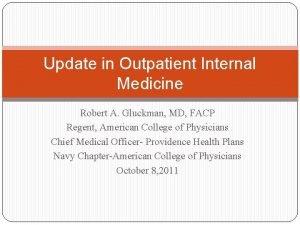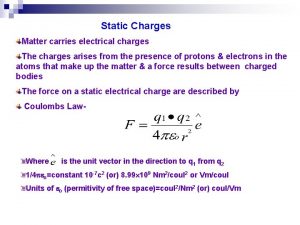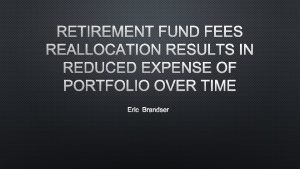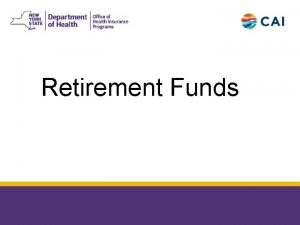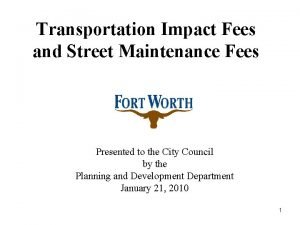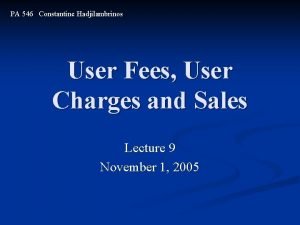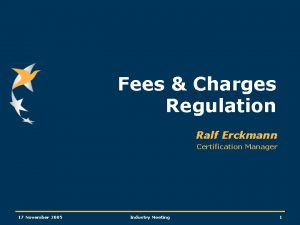retirement fund charges David Gluckman Fees for many










































- Slides: 42

retirement fund charges David Gluckman

‘Fees for many products in the financial sector remain too high. High costs in savings products undermine the national objective of getting our people to save more. The financial industry must take more urgent steps to reduce costs and introduce more appropriate and transparent saving and investment products, including annuities. ’ Finance Minister: Pravin Gordhan. Budget Speech, 22 February 2012

‘These are structural changes and a paradigm shift. At the end of the day government has one interest and that is to ensure that the beneficiaries of the retirement process benefit from their own savings. ’ Finance Minister: Pravin Gordhan. Media release ‘Strengthening Retirement Savings’ May 2012

charges actual levies, administration fees, or policy deductions that reduce the retirement savings of an individuals over his or her lifetime costs expenses incurred by the provider

good costs versus bad costs http: //youngadventuress. com/wp-content/uploads/2012/09/Cabin-seats. jpg


criticisms • SA very expensive v international benchmarks - especially retirement annuities • SA a mature system yet charges at level of new systems • required disclosure levels lowfound evidence of charges shifted from upfront to recurring

criticisms • found evidence of shifting between charge types • unjustifiable bias towards active management • relationship between complexity, intermediation and charges • simpler products would suffice for vast majority • concerns about conflict of interest models


Benchmark 2013 Standalone survey 1. 2. 3. 4. service levels price administrator size fund – administrator relationship 5. brand 6. administrator – benefit consultant relationship 7. fund – benefit consultant relationship Administrator Q. most important factors when choosing. . . 1. 2. 3. 4. 5. 6. past performance price / compensation structure service levels investment manager size brand fund – investment manager relationship 7. investment manager – benefit consultant relationship Investment Manager

Benchmark 2013 Umbrella Fund survey Q. most important reasons for joining your chosen provider

Benchmark 2013 Umbrella Fund survey detailed charges for 41 participating employers total members 21 903 average # members per employer 534 average monthly salary per member R 14 838 total assets R 4 089 690 807 average assets per employer R 99 748 556 average assets per member R 186 718 operating expenses as % salaries * 0. 78% operating expenses as % contributions * 6. 45% operating expenses as % assets * 0. 90% * unweighted averagesstandalone funds report administration fees only average 0. 9% of salariesexcludes asset management fees

low preservation = high charges • • average member share = 105% of annual salary average member share should be double this 12% of salary net savings x 15 years past employment + compound interest • double the assets without increasing costs. . . implies charges (expressed as % assets) can halve!

3 state solution increased competition must benefit consumers standalone funds umbrella funds • large company funds • sponsor role critical • independence model • view as a product • diligent trustees retail products • compete with umbrella funds at small end • reinvention needed selected as default products by trustees to be

industry standard disclosure principles 1. total charges 6. can be used for any DC fund 2. prospective 7. clearly stated and consistent assumptions 3. objective 8. easy to use 4. apply to actual fund membership / data 9. freely available 10. easily adaptable to changing circumstances 5. consistent easy-to-understand summarised reporting D Gluckman & M Esterhuysen A critique of the umbrella retirement fund charging model : 2011

industry standard disclosure principles 1. total charges 6. can be used for any DC fund 2. prospective 7. clearly stated and consistent assumptions 3. objective 8. easy to use 4. apply to actual fund membership / data 9. freely available 10. easily adaptable to changing circumstances 5. consistent easy-to-understand summarised reporting D Gluckman & M Esterhuysen A critique of the umbrella retirement fund charging model : 2011

R 24 (inc VAT) total cost of ownership (“TCO”) ‘The work on a single cost-declaration structure is being undertaken by a standing committee of the financial services industry organisation, the Association for Savings & Investment SA (ASISA). ‘The ASISA committee, the Universal Disclosures Standing Committee, … was established by ASISA in 2009 to look at ways information, particularly about costs, could be disclosed to all investors in a meaningful and comparable way’. Four years later it has not reached its goal. ASISA … says the work is progressing well, but is slow because of the complexities involved in standardising disclosure of costs for products that are fundamentally different in structure. The standing committee aims to complete this piece of work during 2013. ’ 13 volume 55 nd 2 0 www. persfin. co. za 2 r rte FINANCE ua Q ERSONAL P ‘a universal measure for costs’

Sanlam Umbrella Fund charge analysis 2013 number of members 51 265 number of employers 863 average members per employer 59 total assets R 7 005 m average assets per member R 136 639 average monthly salary per member R 13 277

Sanlam Umbrella Fund charge analysis 2010 2013 2011 2012 number of members 26 51 339 265 36 679 42 258 number of employers 698 863 805 869 average members per employer 38 59 46 49 total assets R 2 R 7 160 m 005 m R 3 638 m R 4 538 m average assets per member R 136 R 57 234 639 R 99 198 R 107 397 average monthly salary per member R 13 R 8 968 277 R 10 095 R 11 616

Sanlam Umbrella Fund mean reduction in yield 2010 2011 2012 2013 1. 65% 1. 70% 1. 90% 2. 01%

charge differentials appear to be contracting 50 the mean Ri. Y for low earners in 2011 above high earners % 23 in 2013 %

solidarity at work ‘… in group schemes, sophisticated members of the group will act as buyers for all, while communal pressures or regulatory intervention can prevent exploitation of the weak or naïve’. Professor Anthony Asher 2007




Q. Benchmark 2013 Umbrella Fund survey how often are competitor umbrella fund quotations sought? annually 32% every two years 10% every three years 11% sub total 53% 36% in 2010 never 23% 34% in 2010

when the student is ready. . . the teacher will appear

Benchmark 2013 Umbrella Fund survey Q. how would you prefer to have administration fees expressed? Rand pm pm 32% % salary 45% % contribution 15% % assets 0% combination 3% don’t know 5% total 100%

‘one off-the-wall idea would be to compel all charges (including administration fees, consulting fees and investment management fees) to be levied as a flat percentage of assets under management which would have the dual advantage of facilitating easy market comparisons, and entrenching further what could be regarded as desirable cross-subsidies between the rich and the poor’. D Gluckman. Retirement Fund Reform for Dummies, 2009

‘From a purely financial perspective charges are most equitable when they align with the incidence of the underlying expenses. However, this often results in a complex structure, and a compromise is often required for expediency. Furthermore, they impact the lower income groups more than the higher income groups. ”“From a social perspective charges are most equitable when they affect individuals equally, as a proportion of the benefits they receive. ” ASISA National Pension Study 2009

cross-subsidisation key principles • • • cross-subsidies are inherent to group arrangements retirement funds are tax incentivised arrangements maximise wealthy-to-poor cross-subsidies • but limit financial incentive for individual wealthy members to exit group arrangement in favour of individual arrangements • no need for Rand contribution caps for group arrangements?

cross-subsidisation policies. . . can EB learn from retail? % assets charges offer many potential benefits • • better cross subsidies • • • consistency between institutional and retail markets alignment of interests between product providers, intermediaries and consumers easier for consumers to determine total charges significantly reduced financial benefit to shift charges between different elements

% of assets administrator 0. 4% benefit consultant 0. 2% investment consultant 0. 1% investment manager 0. 6% external auditor 0. 1% other 0. 1% total Ri. Y 1. 5% so much easier to understand? the only important charge measure?

gap between NT demand what industry can realistically deliver might be too big

F L I A D E

house view global balanced portfolios exposure to SA financial services Allan Gray 9. 2% Coronation 4. 4% Investec 19. 7% Investment Solutions 11. 0% Old Mutual 10. 8% Prudential 13. 4% Sanlam 10. 6% Stanlib 8. 5% Average 11. 0%

reducing charges without reducing costs. . . can hurt members Mkt cap (R'm) 5 bps 10 bps 15 bps 20 bps 25 bps SLM 95, 300 -1. 8% -3. 6% -5. 4% -7. 2% -9. 1% MMI 35, 800 -3. 6% -7. 2% -10. 7% -14. 3% -17. 9% OML 136, 300 -1. 8% -3. 6% -5. 4% -7. 2% -9. 0% 32, 900 -4. 3% -8. 6% -12. 8% -17. 1% -21. 4% 20, 000 -17. 50% -35% -42. 50% -57. 50% -3. 24% -6. 47% -9. 08% -11. 69% -14. 30% LBH CML average (weighted) i. e. 25 bps charges reduction equates to a 1. 57% reduction in capital values assuming 11% average exposure to SA financial services (valuations performed by Sanlam Investment Management)

Government’s role • • provide tax incentivesset the boundaries • unfettered competition problematic • reasonable approach given tax incentives create conditions for increased competition regulator - not player lighter touch rather than intrusive regulation • alignment of incentives - very powerful • instill rather than regulate principles • increased costs always get charged to consumers over time

a healthy debate • charge measures are going in the right direction • gradualist approach strongly recommended • competition can / should be a powerful force to reduce charges • let institutional and retail products compete • improved preservation is a silver bullet

a healthy debate • • support simplification of product design • appropriate defaults • product standardisation • trend towards passive fund management will reduce charges TCF principles yes. . . bureaucracy no

AGREE! • agree with National Treasury – regulation should not aim to restrict competition but rather to enable the right type of competition

good costs versus bad costs
 Like charges blank and opposite charges blank
Like charges blank and opposite charges blank Josh gluckman
Josh gluckman Robert gluckman
Robert gluckman Ywca retirement fund
Ywca retirement fund Imprest system and fluctuating
Imprest system and fluctuating Kontinuitetshantering i praktiken
Kontinuitetshantering i praktiken Novell typiska drag
Novell typiska drag Nationell inriktning för artificiell intelligens
Nationell inriktning för artificiell intelligens Ekologiskt fotavtryck
Ekologiskt fotavtryck Varför kallas perioden 1918-1939 för mellankrigstiden?
Varför kallas perioden 1918-1939 för mellankrigstiden? En lathund för arbete med kontinuitetshantering
En lathund för arbete med kontinuitetshantering Adressändring ideell förening
Adressändring ideell förening Tidbok
Tidbok A gastrica
A gastrica Vad är densitet
Vad är densitet Datorkunskap för nybörjare
Datorkunskap för nybörjare Boverket ka
Boverket ka Hur skriver man en tes
Hur skriver man en tes Delegerande ledarstil
Delegerande ledarstil Nyckelkompetenser för livslångt lärande
Nyckelkompetenser för livslångt lärande Påbyggnader för flakfordon
Påbyggnader för flakfordon Formel för lufttryck
Formel för lufttryck Offentlig förvaltning
Offentlig förvaltning Lyckans minut erik lindorm analys
Lyckans minut erik lindorm analys Presentera för publik crossboss
Presentera för publik crossboss Vad är ett minoritetsspråk
Vad är ett minoritetsspråk Plats för toran ark
Plats för toran ark Klassificeringsstruktur för kommunala verksamheter
Klassificeringsstruktur för kommunala verksamheter Epiteltyper
Epiteltyper Claes martinsson
Claes martinsson Centrum för kunskap och säkerhet
Centrum för kunskap och säkerhet Verifikationsplan
Verifikationsplan Mat för unga idrottare
Mat för unga idrottare Verktyg för automatisering av utbetalningar
Verktyg för automatisering av utbetalningar Rutin för avvikelsehantering
Rutin för avvikelsehantering Smärtskolan kunskap för livet
Smärtskolan kunskap för livet Ministerstyre för och nackdelar
Ministerstyre för och nackdelar Tack för att ni har lyssnat
Tack för att ni har lyssnat Vad är referatmarkeringar
Vad är referatmarkeringar Redogör för vad psykologi är
Redogör för vad psykologi är Borstål, egenskaper
Borstål, egenskaper Tack för att ni har lyssnat
Tack för att ni har lyssnat Borra hål för knoppar
Borra hål för knoppar


